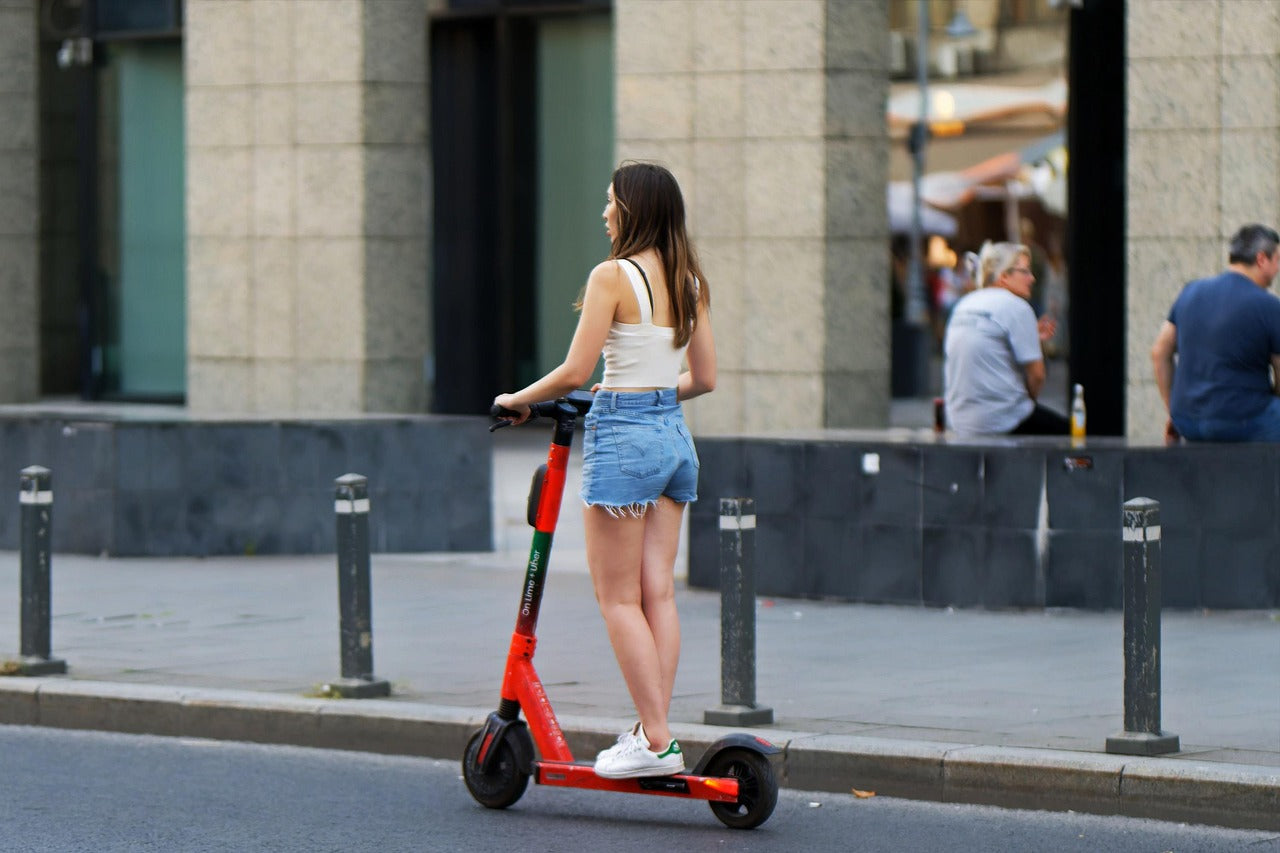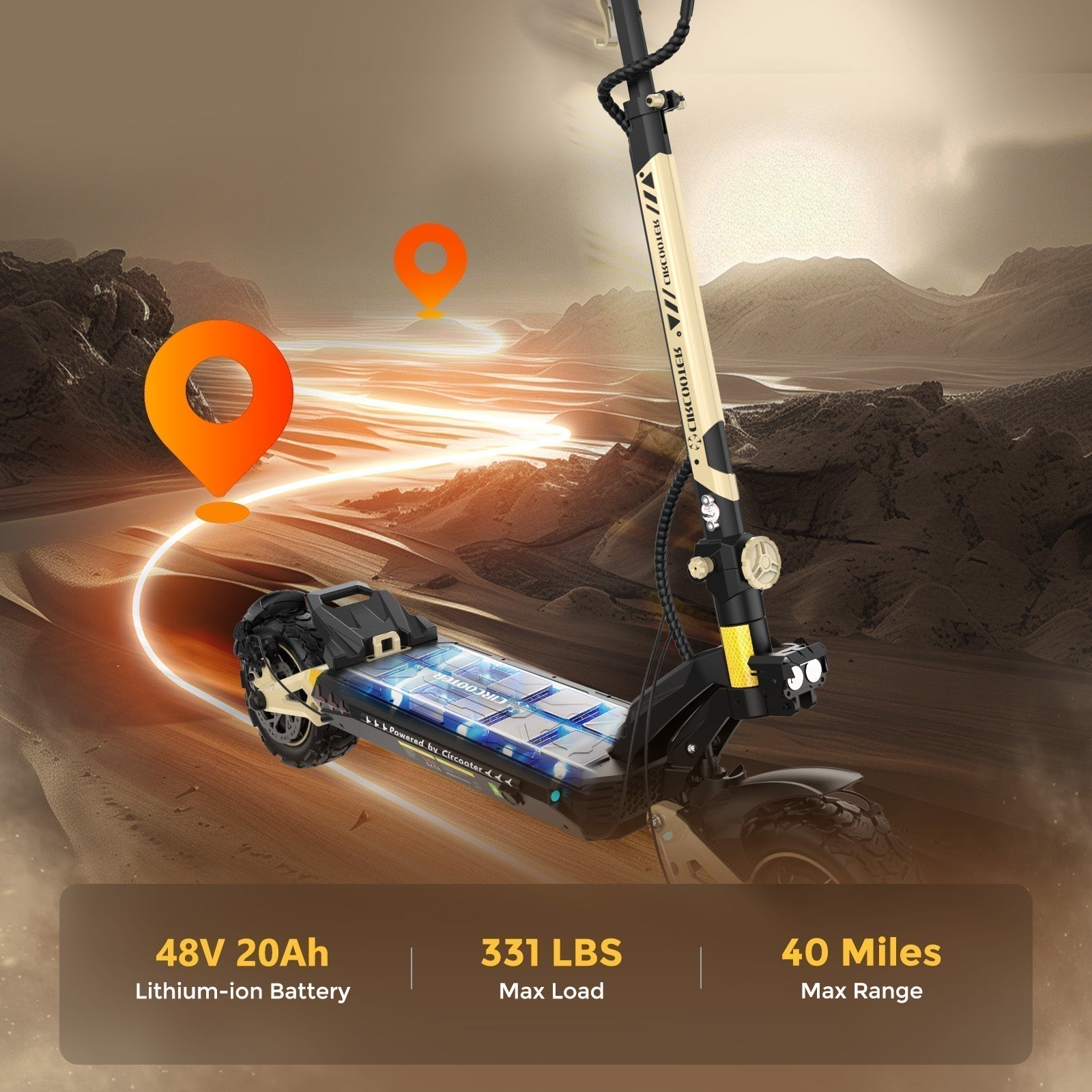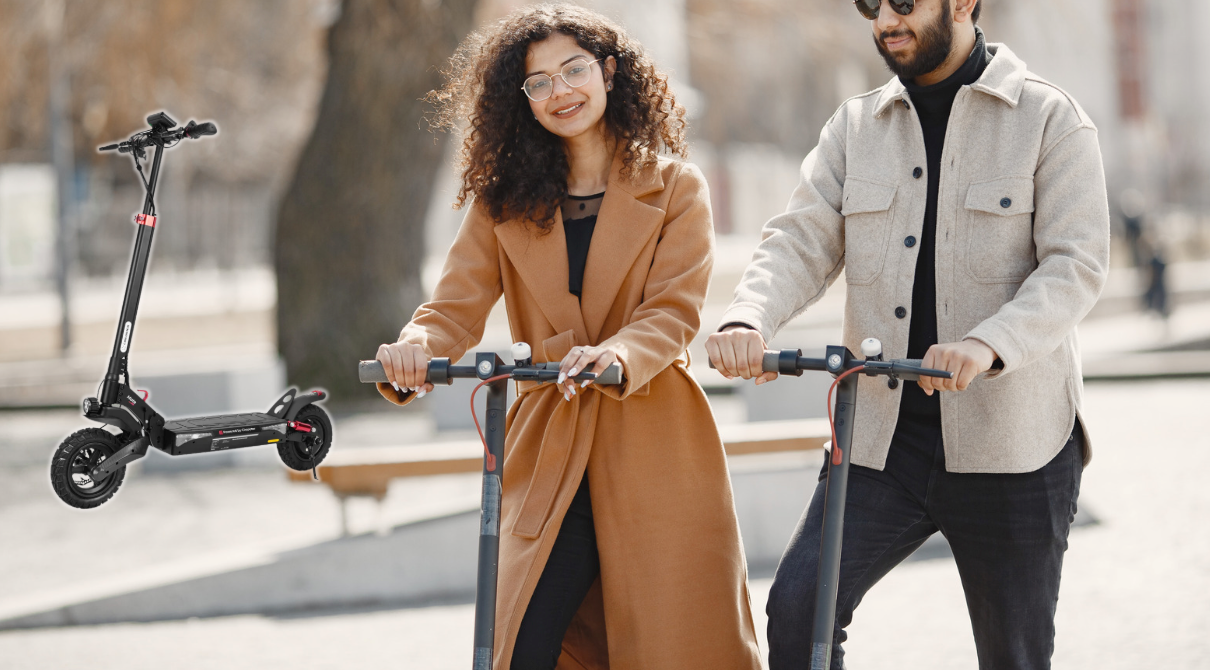How fast do electric scooters go? Most city models reach 15-25 mph (24-40 kph), providing the perfect balance between efficiency and safety for urban commuting.
This speed range lets you breeze past pedestrians and often outpace cars stuck in traffic jams. Standing on a compact platform just inches from the ground, even 18 mph delivers a surprisingly exhilarating experience!
For thrill-seekers, high-performance models push boundaries with jaw-dropping speeds—some reaching 45, 80, or even 100 mph in extreme cases.
Ready to find the perfect speed for your lifestyle? Read on to discover which scooter class matches your need for speed.
Common Electric Scooter Speeds By Category
Electric scooters come in different speed categories to match various needs and skill levels. Speed capabilities usually align with price points and the scooter's intended use.
|
Category |
Speed Range |
Motor Power |
Key Features |
Price Range |
Best For |
|
Budget |
10-15 mph |
250-350W |
Single motor, lightweight design, simple brakes |
$200-400 |
Beginners, casual neighborhood rides, campus travel |
|
Commuter |
15-25 mph |
350-600W |
Better suspension, 15-30 mile range, multiple riding modes |
$400-800 |
Daily commuting, errands, urban transportation |
|
Performance |
25-40 mph |
1000-2000W (dual) |
Advanced suspension, premium brakes, reinforced frame |
$1,000-2,000 |
Longer commutes, rough terrain, hill climbing |
|
Extreme |
40+ mph |
2000-5000W (dual) |
Professional suspension, motorcycle-grade brakes, cooling systems |
$2,500-4,000+ |
Experienced riders, off-road adventures, thrill-seeking |
Budget Electric Scooters (10-15 mph)
Budget models offer beginner-friendly speeds of 10-15 mph using 250-350W motors. These entry-level options feature single motors, basic braking systems, and lightweight designs under 30 pounds.
Priced at $200-400, they provide sufficient speed for neighborhood trips while their modest power extends battery life.
Commuter Electric Scooters (15-25 mph)
Commuter scooters hit the sweet spot at 15-25 mph, ideal for daily urban transportation. With 350-600W motors, these mid-range models offer improved suspension, 15-30 mile range, and multiple riding modes for different environments.
Priced between $400-800, they deliver better build quality with practical features like enhanced lighting and smartphone connectivity.
Performance Electric Scooters (25-40 mph)
CIRCOOTER Mate All-terrain E-Scooter
Performance models reach impressive 25-40 mph speeds, rivaling mopeds and many e-bikes. These powerful scooters combine dual motors (1000-2000W total), sophisticated suspension, premium brakes, and reinforced frames that confidently tackle hills and rough terrain.
Priced between $1,000-2,000, they offer superior components, durability, and weather resistance.
For exceptional performance in this category, the CIRCOOTER Mate All-terrain E-Scooter delivers with dual 800W motors, advanced suspension, and hydraulic disc brakes for both thrilling speed and confident control.
Extreme Speed Electric Scooters (40+ mph)
Extreme scooters exceed 40 mph, with elite models reaching 60+ mph. These high-performance machines feature massive dual motors (2000-5000W), professional-grade suspension, advanced cooling systems, and motorcycle-caliber brakes.
Starting at $2,500, they require full protective gear and considerable riding experience, with usage often restricted on public roads due to their exceptional capabilities.
For enthusiasts seeking this elite performance, the CIRCOOTER Cruiser Pro delivers extraordinary power and precision at just $1,299.99—far below the typical entry price for this category.
What Determines How Fast An Electric Scooter Can Go

Electric scooter speed depends on several key factors that work together. Here’s a guide to help you choose the right scooter for your needs and know what affects performance.
Motor Power And Speed Relationship
Motor wattage directly influences velocity. Commuter models with 250-500W motors typically reach 15-20 mph, while high-performance 1000W+ motors can exceed 30 mph. Dual-motor setups effectively double this power.
Motor efficiency matters—a well-designed 500W motor can outperform a poorly built 600W unit. Riding conditions affect performance, with hills reducing speed compared to flat terrain.
Battery Voltage Impact On Top Speed
Voltage is a key determinant of maximum speed capability. Entry-level models use 24V or 36V systems, while performance scooters employ 48V, 52V, or 60V batteries for higher speeds.
Battery health impacts performance—as charge depletes or batteries age, voltage drops, reducing top speed during rides. This is consistent with electrical principles and real-world performance.
Weight Capacity Vs. Actual Speed
Rider weight directly affects real-world speed. While the exact numbers vary by model, a scooter will generally perform better with lighter loads. Most manufacturers test with riders around 150-165 pounds.
Additional items like backpacks further impact performance by increasing total weight. Most consumer scooters have weight capacities between 220-330 pounds, which is accurate.
Controller And Speed Modes
The controller regulates power flow through different speed modes, typically offering:
- Eco/Low mode for efficiency
- Normal/Medium mode for balanced performance
- Sport/High mode for maximum speed
Many scooters incorporate speed limiters (typically 15-20 mph) for safety and regulatory compliance. This aligns with regulations in many cities worldwide, where scooters are often limited to 15-20 mph by law.
Factors That Affect Your Actual Riding Speed
Your electric scooter's top speed isn't just about what's advertised on the box. Real-world performance depends on several key elements that can make you go faster or slower than expected.
Rider Weight And Speed Performance
Most electric scooters are designed with a specific weight capacity in mind, typically between 220-265 pounds (100-120 kg).
When you exceed this limit, your scooter works harder to move forward. This extra effort drains the battery faster and reduces your top speed. For every 20 pounds over the recommended weight, you might lose 1-2 mph in top speed.
Lighter riders generally experience:
- Faster acceleration
- Higher top speeds
- Extended range
- Less strain on the motor
If you're on the heavier side, consider models with more powerful motors (500W+) and dual motors for better performance. These scooters can maintain higher speeds even with additional rider weight.
Terrain And Incline Effects On Speed
The ground you ride on dramatically changes your scooter's performance. Smooth pavement lets you reach maximum speeds, while rough surfaces slow you down considerably.
Different terrains affect speed:
- Smooth pavement: 100% of max speed
- Rough roads: 70-80% of max speed
- Gravel paths: 50-60% of max speed
- Grass or dirt: 40-50% of max speed
Hills are especially challenging. A typical 300W scooter might handle a 10% grade at reduced speed, while a 15% grade could bring you to a crawl. Most manufacturers rate their scooters for specific incline capabilities.
Good suspension helps maintain speed on bumpy surfaces by keeping your wheels in contact with the ground. Pneumatic (air-filled) tires provide better traction than solid tires, especially on wet or uneven surfaces.
Battery Level And Speed Reduction
Your scooter's battery level directly affects its speed performance. Most electric scooters deliver maximum speed only when the battery is between 50-100% charged.
When battery levels drop below 50%, you'll notice:
- Reduced top speed (up to 20% slower)
- Decreased acceleration
- Less power for climbing hills
This happens because the battery provides less voltage as it depletes. At 20% battery, many scooters automatically enter a power-saving mode that limits speed to extend range.
Battery health matters too. As batteries age over months and years of use, their maximum capacity diminishes.
An older battery might only deliver 80% of its original power, affecting your top speed even when fully charged.
For a comprehensive understanding of how to maximize your battery's performance and lifespan, check out our detailed guide on Factors Affecting Electric Scooter Battery Life.
Weather Conditions That Slow You Down
Environmental factors can significantly impact your riding speed. Temperature affects battery performance—cold weather can reduce your speed by 10-30%.
In temperatures below 40°F (4°C), lithium-ion batteries become less efficient. Your scooter might feel sluggish and reach lower top speeds.
Hot weather above 100°F (38°C) can also reduce performance.
Rain creates hazardous riding conditions that force slower speeds. Wet surfaces reduce traction, increasing braking distance by up to 30%.
For safety, you should reduce speed by at least 25-30% when riding in wet conditions.
Wind resistance becomes noticeable at higher speeds. A strong headwind can reduce your top speed by 3-5 mph.
Conversely, tailwinds might give you a slight boost in speed and range.
How To Safely Maximize Your Electric Scooter's Speed

Getting the most speed from your electric scooter requires proper care and smart riding. You can boost performance through regular maintenance, using the right riding techniques, and knowing when to switch between speed modes.
Maintenance Tips for Peak Performance
Regular maintenance dramatically impacts your scooter's speed capability. Here are tips to keep in mind:
- Keep tires properly inflated to reduce rolling resistance and improve range—check pressure weekly with a gauge for optimal results.
- Clean your scooter regularly, focusing on wheels and motor areas where friction-causing dirt accumulates.
- Inspect for loose components that create drag. Tighten any wobbling handlebars or folding mechanisms to maintain structural integrity.
- Proper battery care ensures consistent power delivery—avoid complete discharges and follow manufacturer charging guidelines.
- Finally, regularly lubricate moving parts like bearings and folding joints to minimize resistance.
Conclusion
Electric scooters typically reach 15-25 mph, balancing safety with urban mobility. Your actual speed depends on motor power, battery health, rider weight, terrain, and weather conditions.
Local regulations often impose speed limits, so check your area's rules before riding.
For exceptional performance, consider Circooter's premium electric scooters. The Circooter Mate features an impressive 48V 12.5Ah battery providing extended range, while the G1 Pro boasts powerful dual 800W motors delivering thrilling speeds up to 28 mph.
Check out Circooter's full electric scooter collection today for the perfect balance of speed, range and innovative safety features.
Frequently Asked Questions
What is the average top speed of an electric scooter?
Most electric scooters reach top speeds between 15-25 mph (24-40 kph). This range works well for typical urban commuting needs.
Commuter models usually max out around 20 mph, which balances safety with getting places quickly. Higher-end scooters may reach faster speeds, but the average scooter you'll find for everyday use stays in this range.
What factors determine the maximum speed of electric scooters?
Motor power greatly affects how fast your scooter can go. Scooters with 250-350W motors reach lower speeds than those with 500W+ motors.
Battery capacity impacts sustained speed performance. Larger batteries can deliver more consistent power during longer rides.
Your weight matters too. Heavier riders may not reach the advertised top speed. Terrain also plays a role—going uphill slows you down, while flat surfaces let you reach maximum speeds.
Are there legal speed limits for electric scooters on public roads?
Many cities and countries limit electric scooters to 15-20 mph (24-32 kph) on public roads. Some places set even lower limits of 10-12 mph in pedestrian areas.
You should check your local laws before riding. Speed limits vary widely between locations.
Breaking speed limits can result in fines or having your scooter confiscated in some areas. Safety regulations exist to protect both riders and pedestrians.
How does the speed of children's electric scooters compare to adult models?
Children's electric scooters typically max out at 10 mph (16 kph) or less. This lower speed helps keep young riders safe.
Many kids' models include speed limiters that parents can adjust. This feature lets you set appropriate speeds based on your child's age and experience.
Adult models go much faster because they're designed for commuting and transportation rather than just play.
Can electric scooters be modified to go faster than their original top speed?
Some scooters can be modified by removing speed limiters through their apps or controller settings. This might void your warranty though.
Upgrading motors or batteries can increase speed but requires technical knowledge. Not all scooters support these modifications.
Be aware that modifying your scooter may make it illegal to ride in public. Modified scooters might also become unsafe if they exceed design specifications.






Leave a comment
This site is protected by hCaptcha and the hCaptcha Privacy Policy and Terms of Service apply.